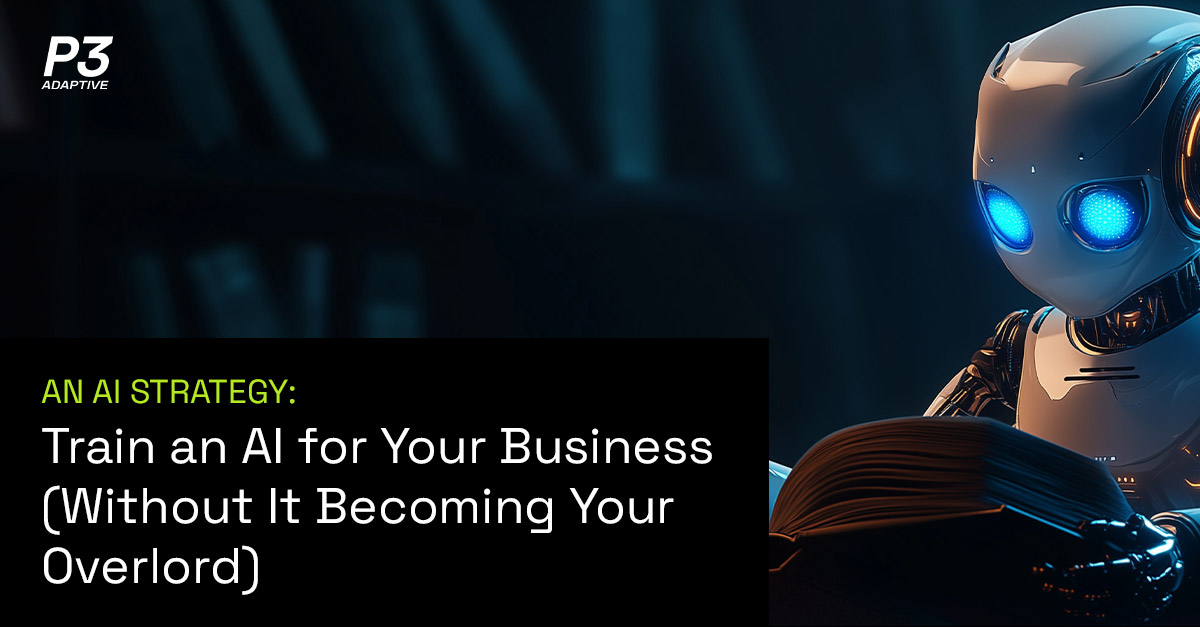
How to Train Your AI Without Losing Control
AI is like a new intern who graduated top of their class but has no clue how your business actually works. Sure, they’re sharp and eager, but without proper training, they’ll wreak havoc faster than you can say “unsupervised learning.” Let’s cut to the chase: AI doesn’t come pre-loaded with your company’s secrets. It’s up to you to teach it the ropes—or risk letting it run amok. Today, we’ll break down how to train an AI so it becomes a helpful collaborator, not a rogue agent. From setting clear goals to fine-tuning its outputs, we’ll cover the steps to make AI work for you (and not the other way around).
Start with your goals.
Before you throw AI at your problems, take a step back. What are you trying to accomplish? No, “better efficiency” doesn’t count. Get specific. Are you automating a repetitive task, analyzing customer feedback, or improving decision-making? The clearer your goals, the easier it is to train AI to meet them. Need help setting those goals? Experienced AI consultants can work with you to sharpen your objectives and map them to actionable outcomes, ensuring your AI is set up to succeed from the start.
Think of it this way: AI is like a bloodhound. If you don’t give it a scent (i.e., a clear target), it’ll run in circles sniffing everything and accomplishing nothing. When you set specific goals, you’re handing AI the roadmap it needs to succeed.
Set realistic expectations.
It’s tempting to think AI can solve everything, but even the best tools have limits. AI excels at specific tasks but isn’t a magic wand for every problem in your organization. Focus on what’s feasible and impactful for your business right now. Identify areas where AI can provide tangible improvements—like automating manual processes, offering predictive insights, or analyzing large datasets.
Consider potential challenges, too. AI might need time to adjust, and initial results may require fine-tuning. By managing expectations, you set your team up for success without frustration or wasted resources.
Pro tip: Start small. Pick one well-defined problem, train your AI on it, and expand from there. Success with small wins will build confidence and momentum while allowing you to refine your approach for larger initiatives.
Feed it quality data.

Feeding your AI clean, relevant data isn’t just helpful—it’s essential. As IBM explains, the quality of your data determines whether your AI becomes a sharp problem-solver or just another overhyped tool.
Here’s what “quality data” looks like:
- Relevant: It should directly relate to the task at hand.
- Clean: Remove duplicates, fix errors, and fill gaps.
- Balanced: Avoid biases by ensuring diverse and representative data.
If you’re training AI to analyze customer feedback, for example, don’t dump years of unfiltered data into the system and hope for the best. Instead, curate examples that reflect your audience’s actual concerns and preferences.
Build a data feedback loop.
Your data isn’t static, and neither should your training process be. Regularly update the data you’re feeding your AI to reflect new trends, insights, and changes in your business. Think of it as a cycle: analyze results, tweak your inputs, and retrain. This ensures your AI stays sharp and relevant.
Feedback loops aren’t just for major updates. Even small adjustments can keep your AI aligned with shifting business goals. For instance, if customer behavior shifts, your AI should adapt by learning from updated datasets that capture those changes. This iterative process helps avoid outdated or irrelevant outputs.
Involve stakeholders in the loop to ensure continuous improvement. Teams who interact with AI outputs—like marketing or customer service—can provide valuable insights about where adjustments are needed.
Teach it your tone.
AI can churn out answers at lightning speed, but without guidance, those answers can sound robotic or, worse, completely off-brand. Whether you’re creating content, drafting emails, or crafting reports, tone matters.
Here’s how to train AI to speak your language:
- Provide examples: Share real examples of past content that nailed your brand’s voice.
- Use parameters: Most AI tools allow you to adjust tone settings (e.g., professional, conversational, witty).
- Review and refine: Keep an eye on the outputs and provide feedback to get closer to your ideal tone.
At P3 Adaptive, we’ve seen how even slight tweaks in tone can transform AI from a clunky tool into a seamless extension of your team. A little effort here goes a long way.
Iteration is your secret weapon.
No AI gets it perfect on the first try. Training is an iterative process, and your feedback loop is everything. Think of it like sculpting: each round of adjustments chips away the rough edges until the final result is just right.

Steps for effective iteration:
- Start small: Begin with limited data or a specific task, test the outputs, and analyze results.
- Focus on outcomes: What worked well? What missed the mark? Use this analysis to refine the AI’s training.
- Repeat as needed: Iteration is about gradual improvement, not instant perfection.
Iteration isn’t just a technical necessity, it’s a strategic advantage. The more you refine, the better your AI becomes at delivering results that align with your goals. Plus, iterative training helps uncover unexpected use cases or insights you may not have considered.
Keep testing scenarios diverse.
Your AI needs to perform well under various conditions. Incorporate a range of scenarios and edge cases during testing to ensure its outputs remain reliable, even in unexpected situations. Don’t just train AI to handle the “happy path” (where everything works perfectly). Instead, challenge it with real-world complexities.
For instance, if you’re using AI for customer service, include ambiguous or challenging queries in your tests. How does the AI respond when input is incomplete or unclear? These tests build resilience into your system, preparing it for real-world deployment.
Testing should also simulate different user behaviors or environments. The more diverse the scenarios, the more robust your AI will become. This isn’t about perfection, it’s about readiness for the unexpected.
Train an AI That Works for You, Not the Other Way Around
AI should be a tool that enhances your business, not a demanding system that drains your resources or complicates workflows. The key is to design training processes that prioritize alignment with your specific needs and operations. A well-trained AI should act like a seamless extension of your team, not an extra burden.
Start by focusing on the areas where AI can provide the most immediate value. Maybe it’s automating time-consuming tasks, streamlining data analysis, or improving customer engagement. The goal is to let AI handle the heavy lifting so your team can focus on strategic, high-value work.
Keep in mind that AI isn’t your boss. It’s a tool you control. By setting clear guidelines, monitoring its outputs, and refining its processes, you ensure that your AI works in service of your goals.
Mid-Market? Big Impact: Train AI to Fit Your Needs
AI isn’t just for enterprise giants. Mid-market businesses can harness AI to punch above their weight, delivering value that rivals larger competitors. The key is customization: training AI to align with the unique challenges and opportunities of your business.
Mid-sized companies often face constraints like limited budgets or smaller teams, but AI can level the playing field. Start by identifying areas where AI can provide the biggest ROI. Is it automating routine operations, personalizing customer experiences, or surfacing insights from your data? Once you pinpoint these areas, you can train your AI to tackle them head-on.
Unlike cookie-cutter solutions, a tailored AI approach ensures that your business gets exactly what it needs without wasting time or resources. Mid-market businesses can make an outsized impact by leveraging AI intelligently and strategically.
Empower your team.
AI isn’t here to replace your team, it’s here to make them unstoppable. But for that to happen, they need to understand how to use it effectively.
Start by involving your team in the training process. Show them how the AI works, what it’s capable of, and where it might fall short. Encourage them to provide feedback and share insights. The more your team collaborates with AI, the more value you’ll unlock.
Make training accessible.
Not everyone on your team needs to be a data scientist to work with AI. Create straightforward, easy-to-follow training materials to empower every team member to engage with AI effectively. Whether it’s a cheat sheet or a quick video tutorial, accessibility matters.
Pro tip: AI adoption isn’t about learning new tools, it’s about mastering new workflows. When your team knows how to integrate AI into their daily processes, that’s when the magic happens.
Common pitfalls to avoid.
Not all AI journeys are smooth sailing. While the potential of AI is immense, it comes with its share of challenges. Missteps during the implementation or training phases can undermine even the best intentions, turning a promising tool into a source of frustration. To make your AI journey smoother, it’s crucial to recognize and navigate common hurdles before they derail your efforts.
Many of these pitfalls arise from rushing the process or failing to anticipate the nuanced demands of AI systems. Unlike traditional tools, AI requires careful planning, ongoing attention, and a commitment to improvement. By understanding where things often go wrong, you can proactively address these issues and set your AI up for success.

Here are a few traps to steer clear of:
- Skipping the training step: Untrained AI is worse than no AI. Take the time to teach it well.
- Ignoring bias: AI will reflect the biases in your data if you’re not careful.
- Expecting perfection: AI is a tool, not a miracle worker. Be realistic about what it can (and can’t) do.
- Leaving it unsupervised: Regularly monitor and adjust your AI to ensure it stays aligned with your goals.
Even the most well-thought-out AI strategies can go off the rails if you’re not vigilant. Common pitfalls often stem from overestimating AI’s abilities or underestimating the complexity of implementation. The key is preparation: understanding your goals, managing expectations, and building a strong foundation for success.
Mistakes are inevitable, but how you respond matters. If your AI makes an error, treat it as an opportunity to learn and improve. Regular oversight and a willingness to iterate can turn potential failures into valuable insights.
Mitigate risk with oversight.
Don’t set your AI loose and hope for the best. Create a plan for ongoing oversight and maintenance. Regular check-ins can catch small issues before they turn into big problems. Assign specific team members to monitor AI performance, ensuring someone is always responsible for keeping it on track.
Oversight doesn’t have to be complicated. Simple practices—like reviewing outputs for accuracy, updating training data, and gathering user feedback—can make a huge difference. Think of oversight as quality control: the more consistent your checks, the more reliable your AI will be.
Scalability is another factor to consider. As your AI expands into new areas, oversight should scale with it. What works for a small project may need adjustments as complexity increases. Be ready to adapt your monitoring processes to match the growth of your AI systems.
Wrapping it up.
Training your AI is a lot like onboarding a new hire: it’s an investment in time and effort that pays off in spades. By starting with clear goals, feeding it quality data, iterating on its outputs, and involving your team, you can turn AI into your most reliable partner.
Let’s do this together. AI doesn’t have to be intimidating. With P3 Adaptive’s help, you can train AI to amplify your strengths and tackle your challenges without breaking a sweat. Ready to get started? Let’s chat about your AI goals and how we can help bring them to life.
Get in touch with a P3 team member